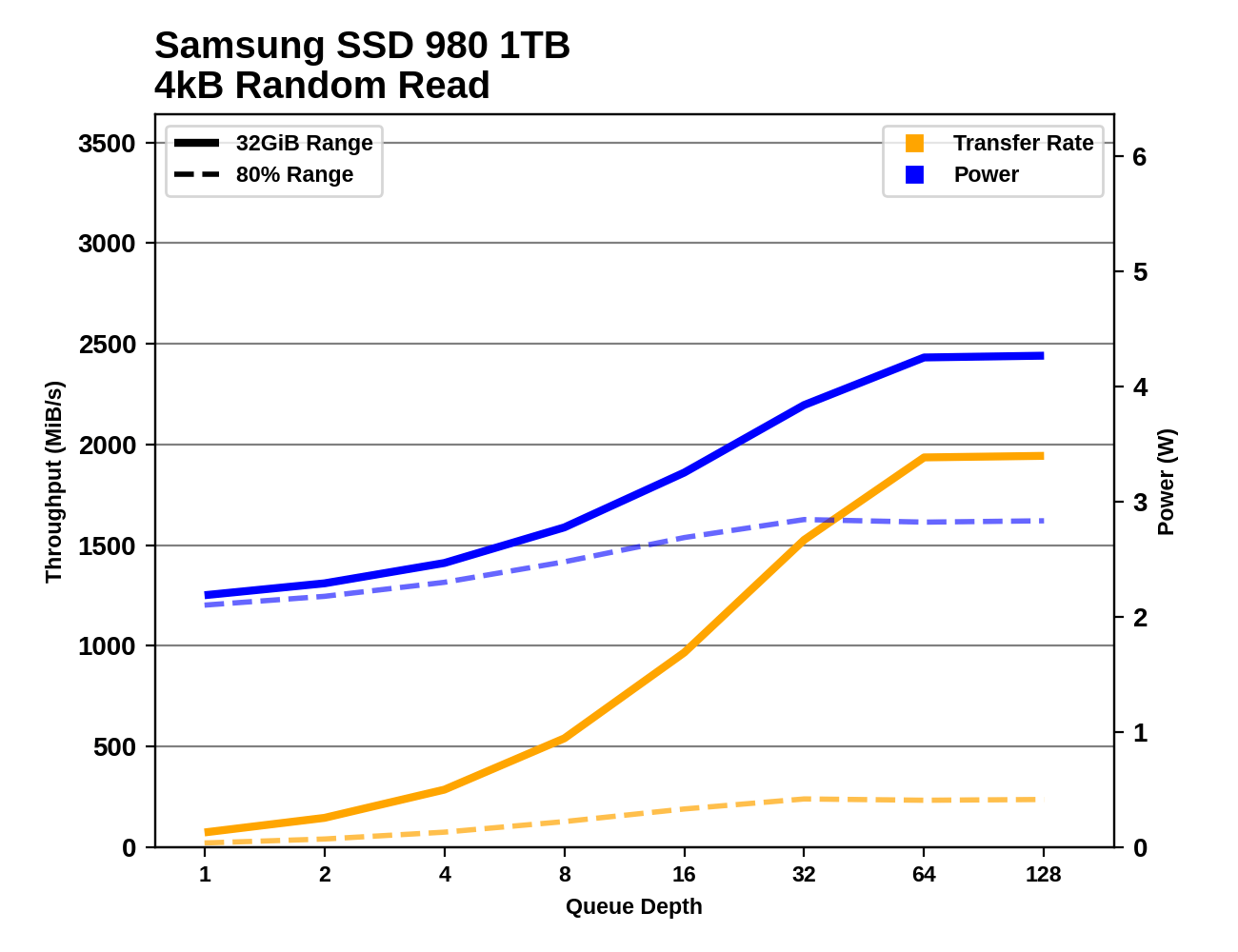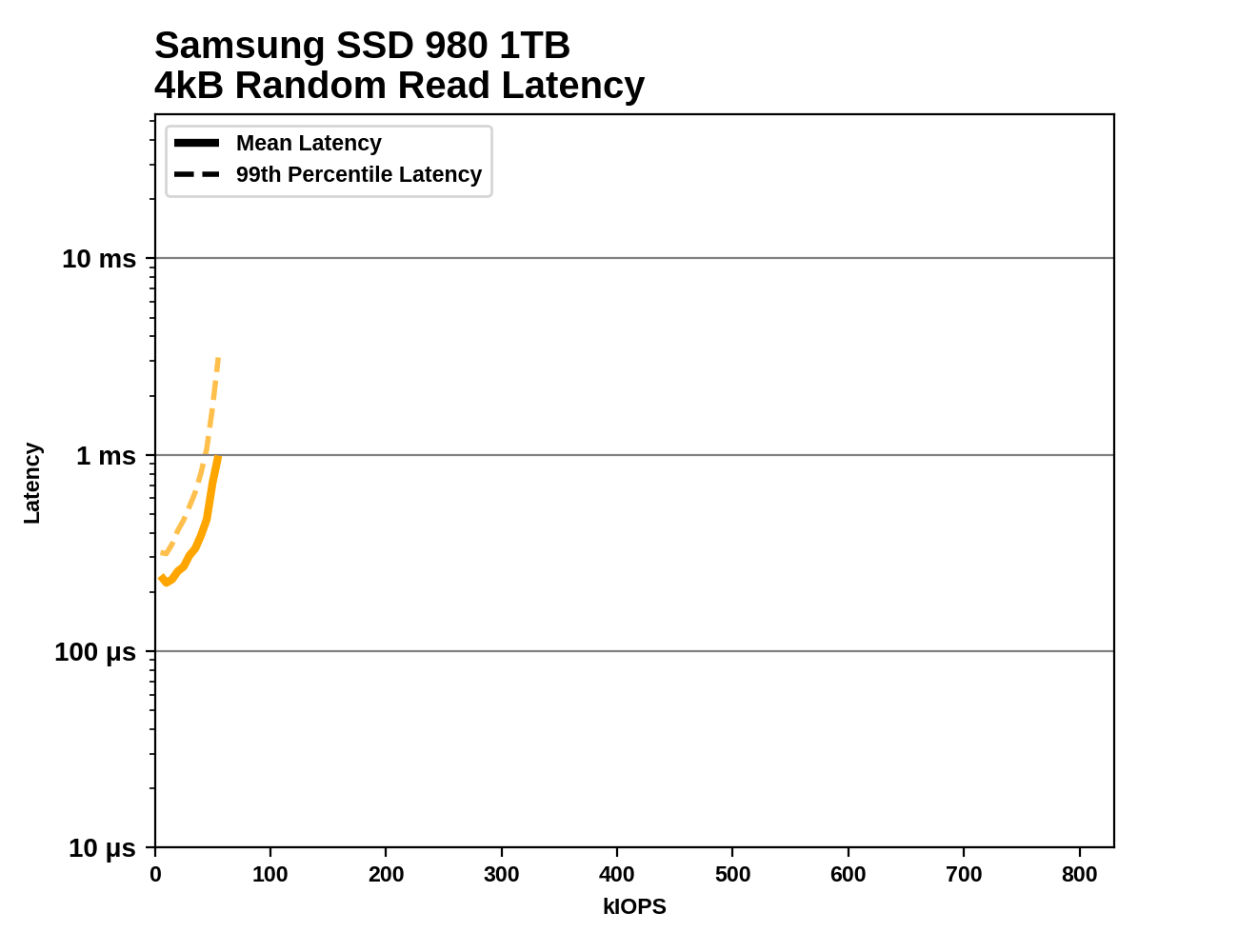The Samsung SSD 980 (500GB & 1TB) Review: Samsung's Entry NVMe
by Billy Tallis on March 9, 2021 10:00 AM ESTBurst IO Performance
Our burst IO tests operate at queue depth 1 and perform several short data transfers interspersed with idle time. The random read and write tests consist of 32 bursts of up to 64MB each. The sequential read and write tests use eight bursts of up to 128MB each. For more details, please see the overview of our 2021 Consumer SSD Benchmark Suite.
 |
|||||||||
| Random Read | Random Write | ||||||||
| Sequential Read | Sequential Write | ||||||||
Given that the Samsung SSD 980 is a DRAMless drive with aggressive SLC caching, it's no surprise to see that most of the burst IO scores show a big difference between testing a small slice of a mostly-empty drive and testing across an 80% full drive. The test runs with the NVMe Host Memory Buffer feature disabled also show how important that is to enabling random IO performance. In the best cases, the SSD 980 even manages to deliver better QD1 random read performance than the 980 PRO. However, when testing against a large data set (or with HMB disabled), the SSD 980's performance only remains competitive for sequential reads. For the other IO patterns, its performance drops far more than typical for entry-level drives.
Sustained IO Performance
Our sustained IO tests exercise a range of queue depths and transfer more data than the burst IO tests, but still have limits to keep the duration somewhat realistic. The primary scores we report are focused on the low queue depths that make up the bulk of consumer storage workloads. For more details, please see the overview of our 2021 Consumer SSD Benchmark Suite.
 |
|||||||||
| Random Read | Throughput | Power | Efficiency | ||||||
| Random Write | Throughput | Power | Efficiency | ||||||
| Sequential Read | Throughput | Power | Efficiency | ||||||
| Sequential Write | Throughput | Power | Efficiency | ||||||
When testing under favorable conditions with a small data set, the SSD 980's performance is at the very least competitive with other entry-level NVMe SSDs and sometimes against mainstream drives as well, but it falls apart too easily. Performance on the sustained IO tests shows similar behavior to the burst IO tests with generally quite large performance drops on the SSD 980 when testing is not constrained to a small data set. Bringing in some moderately higher queue depths has helped the sequential write performance catch up somewhat when testing against an 80% full drive.
 |
|||||||||
| Random Read | |||||||||
| Random Write | |||||||||
| Sequential Read | |||||||||
| Sequential Write | |||||||||
When running the sustained IO tests against a 32GB range of the drives, the Samsung SSD 980 shows good performance scaling with increasing queue depths and can eventually achieve quite high throughput. Random reads take a long time to reach full speed at QD64, while random writes and sequential reads saturate around QD8 and sequential writes saturate at QD2. But testing on a wide range of a mostly-full drive reveals lots of problems: random reads and writes are very slow even at extreme queue depths, and the sequential write test frequently overruns the SLC cache.
Random Read Latency
This test illustrates how drives with higher throughput don't always offer better IO latency and Quality of Service (QoS), and that latency often gets much worse when a drive is pushed to its limits. This test is more intense than real-world consumer workloads and the results can be a bit noisy, but large differences that show up clearly on a log scale plot are meaningful. For more details, please see the overview of our 2021 Consumer SSD Benchmark Suite.
 |
|||||||||
This random read latency test paints a pretty bleak picture for the Samsung SSD 980: every other drive in this bunch has lower latency and higher throughput, and the 500GB 980 actually does slightly better than the 1TB. This test is covering 80% of the drive so HMB is no help here, but that applies to the other DRAMless NVMe drives as well.










54 Comments
View All Comments
ptthere - Thursday, June 17, 2021 - link
I think what was implied by "retail-ready," was the idea that OEM builders like Dell, Acer, etc. might use the price-competitiveness of this model with the Samsung name-recognition to package, say, the 500 GB model into their builds. This would go a long way for performance and marketing bragging for sales when compared to lesser performing drives like an other (insert lesser-known name here) 250 GB DRAM-less NVMe.Byte - Monday, August 30, 2021 - link
Samsung has a lot of OEM only drives that most of us has not seen directly. As they have reviewed a few OEM only Samsung SSDs, i think this is why it was written that way.cyrusfox - Tuesday, March 9, 2021 - link
Doesn't look like to me they are targeting the OEM crowd, lazy design as it is a two-sided M.2 stick, by removing the dram should have been easy to get everything on one side.This is solely for the retail market where consumers by and large prefer Samsung , most will pick the cheapest samsung drive and at this price it will be hard to justify a brand that isn't associated with performance.
The whole thing appears to be designed for cost, and I am guessing a two-sided design was the most cost efficient layout(Don't have to double stack NAND dies?). Did you take any picture of the device with the sticker removed, would be interested to see how they chose to populate this. Also impressive the QD1 uplift with HMB enabled.
Wereweeb - Tuesday, March 9, 2021 - link
It's a single-sided drive. The image shows the PCB with and without the label, not the different sides.cyrusfox - Tuesday, March 9, 2021 - link
Dang you are right, my bad, Guess we may see this in OEM laptops then.If only anandtech comments allowed edits, my ignorance will live on forever...
Kurosaki - Tuesday, March 9, 2021 - link
Entry level sizes for over the top prices. Yayy.Oxford Guy - Tuesday, March 9, 2021 - link
Samsung likes to have a catch for trying to spend less, like the dryer I bought. It played an extremely long very irritating song every time the load was finished. Only on the more expensive models could it be turned off. Of course none of the online reviews warned people about this and there was nothing in the big box store about it. Caveat emptor!What did turn up online later, though, were the endless tales of woe from owners whose machines broke an expensive part — the same thing that happened with mine. The dryer only lasted three years or so. Some part on it melts and it's too difficult to replace and too expensive to have serviced.
Last Samsung appliance for me.
UltraTech79 - Monday, March 29, 2021 - link
Dude just unplug the internal cable that connects the internal speaker. No warranties have to be lost hereWereweeb - Tuesday, March 9, 2021 - link
Samsung tried really hard to make an SSD drive with worse value for money than Intel, and I'd argue they still managed to fail.I guess it's fast enough that the typical consumer wouldn't notice the difference, will last longer than Intel's QLC, and the user would still get a fuzzy feeling inside because they bought a Genuine Samsung 980®™
powerarmour - Tuesday, March 9, 2021 - link
A castrated TLC drive is still better than those Intel QLC horror shows.